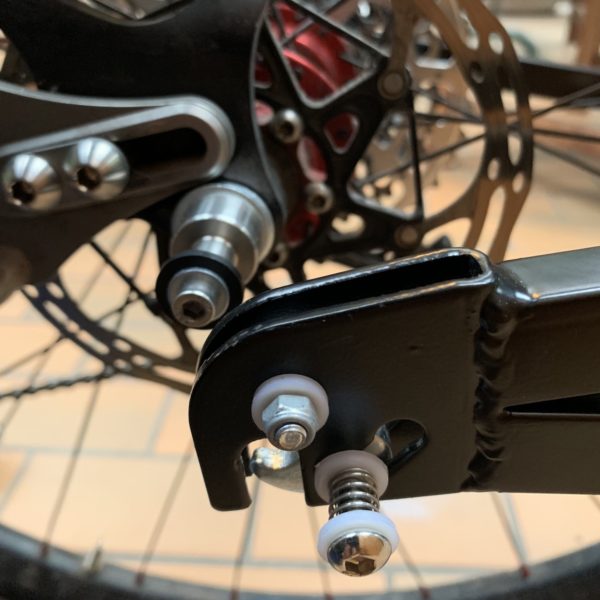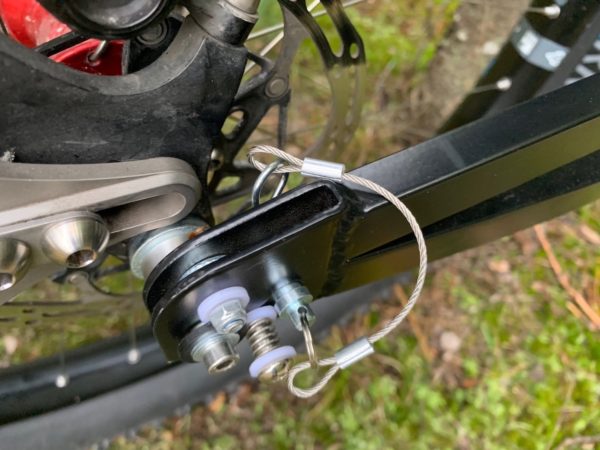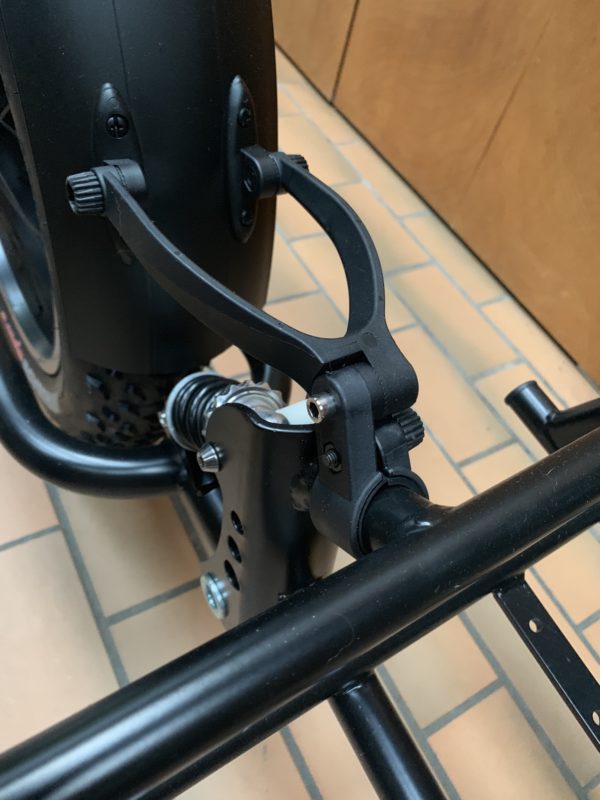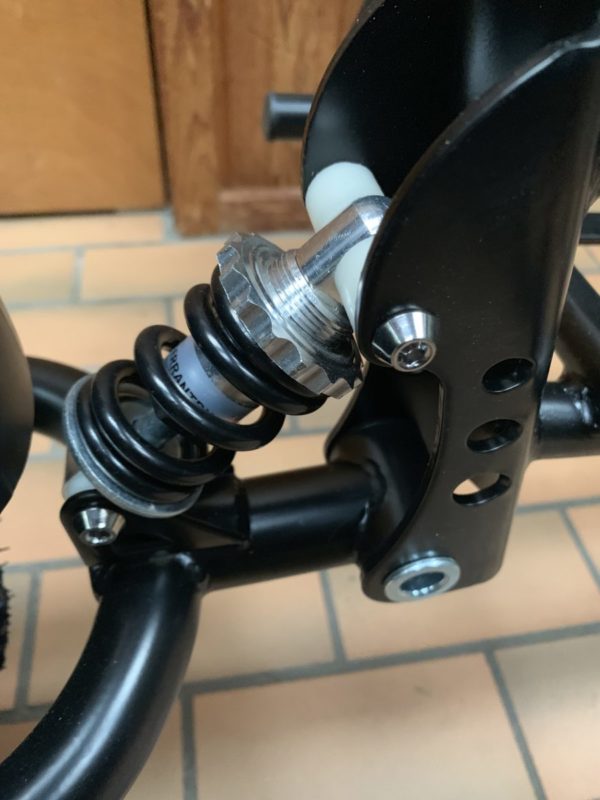
QuietKat is not a company I was familiar with until recently. This is mostly because they specialize in e-fat bikes which are not exactly my jam. Based on the QuietKat site it looks like a big part of their clientele are hunters so they offer a single wheel fat bike trailer to haul hunting equipment in and carcasses out of the woods.
If you are like me, you have been wanting a trailer you can pull with your fat bike for about as long as you have had a fat bike. Maybe it is just me but it seems like a match made in heaven allowing you to take a bike that has a ton of utility and versatility and just make it even more utilitarian by hauling a bunch of stuff. Surprisingly no one has produced a fat bike trailer up until now. Yeah, there have been some great articles on Fat-Bike.com on how to mod a BOB trailer to fit a fat bike and/or run a bigger rear tire with your BOB, but nothing off the rack, ready to roll. Because of this, I was stoked to see that a company finally had made a “BOB style” single wheel fat bike trailer. Without further adieu, let’s dive into the QuietKat Fat Bike Trailer.
I want to get one thing out of the way, the QuietKat trailer is fairly inexpensive compared to other trailer options at only $269 and to hit this price point they had to cut some corners compared to other similar single wheel trailers like the BOB Ibex or the new Burly Coho XC. This isn’t necessarily a bad thing because the lower cost makes the QuietKat more approachable to more riders. That said, I will be very curious how it holds up and works compared to by BOB Ibex trail which I have used for over a decade (and is still going strong).

I got the trailer via Brown Santa and the box was really beat up which had me worried that the trailer would be damaged. Based on my experience, QuietKat does a great job of packing the trailer and everything inside the box was in great shape. The construction of the trailer is stout steel tubing with a durable black powder coat. Welds are not the prettiest but look solid and the trailer frame has a substantial, durable feel to it. There are lots of places to hook bungees or tie-downs so I am guessing it will be pretty easy to secure a load in it.

The rear wheel is 20″ and uses a bolt-on hub with a 4″ Kenda Krusade tire and a Schrader tube. I haven’t checked but am fairly certain this is not a tubeless friendly rim design. The hub came really tight so I cracked out the cone wrenches to adjust it properly but found out something internally is a bit off because there was a really tight spot in the bearings as you rotate the axle. This may wear in over time but doesn’t bode well for long-term durability. It also looks like the seals on the hub are pretty minimal with a basic labyrinth design. This should be interesting because I plan to use this trailer on the beach a fair amount as well as on the snow so the hub bearing sealing should get a good test.
Unlike a BOB trailer with a fixed width yoke attachment to the rear axle of the bike, the QuietKat uses a hinged design to allow it to fit a wide variety of bike hub widths. They include screw-on axle ends if you have a bolt on the rear wheel but it is much more likely that riders will be using an axle from Roberts Axle Project to connect the trailer to a fat bike. The Roberts Axle Project has a wide variety of axles and I was able to swap out my existing thru axle for the Roberts axle no problem and get my bike setup to run the trailer in a matter of minutes.

Similar to a BOB, the QuietKat connects to the bike using a vertical dropout-shaped attachment that slips over the ends of the thru axle. That is where the similarities end and the QuietKat design has a hinged portion that rotates and secures the trailer to the thru axle. The hinged closure secures with a spring-loaded pin and then there is a clevis pin that slides in behind the hinged portion to provide additional security from the trailer coming unhitched. I was very glad to see some redundancy on such an important attachment point.

Upon initial inspection, this seems like a solid attachment system. All of that said, this is one of the areas where the tolerances were not good and one side on my trailer wouldn’t close until I filed some material away so the swinging clasp could get around the axle. I didn’t have to take off that much material and the slight modification I made didn’t compromise the strength of any of the parts but it still isn’t great to need to crack out the file to make a new bike accessory function as it should.

The fender as it comes stock is going to be basically worthless due to the way it attaches to the trailer. There is a hand tightened screw that tightens a shimmed clamp around a round tube just in front of the shock. As sent, there is no way to really tighten down the fender enough and as soon as you hit any bumps it flops to one side or the other. I have some ideas on how I may better secure it but it is still going to be a couple foot long piece of plastic cantilevered over the wheel from a single small attachment point. With some modifications, it may be ok for on-road use but seems very vulnerable to sticks and rocks. There don’t seem to be any provisions for reflectors on the back like a BOB (which is part of the fender) but it shouldn’t take too much ingenuity to find a way to attach some blinking lights to aid visibility.

The shock setup looks like it should work but lacks some of the adjustment that the BOB shock has to tune the shock for different load weights. I look forward to seeing how wide of a window there is for adjusting the shock to effectively work with different cargo weights. One thing I can definitively say is that it makes a fair amount of noise when the shock tops out. This isn’t a deal killer and also is only a bit louder than the rattling coming from the attachment points to the bike axle (which you also get from a BOB) but readers should note that you probably won’t be sneaking up on wildlife riding on bumpy terrain. Once again, I have some ideas on how to potentially cut down on the shock rattling but will need to report back.

Compared to a BOB, the QuietKat is a lot longer. I didn’t measure the difference but estimate it is about 1.5-2 feet longer. In part, this is due to the bigger diameter rear wheel and the longer yoke portion that attaches to the bike, but the shock area is also several inches longer. Cargo area is very similar between the two. A big positive of the QuietKat is that it seems tailor-made to haul a cooler. The BOB was always really compromised on cooler compatibility due to the rounded front of the cargo area so I am stoked this has a more accommodating shape for this precious cargo!
The deck of the cargo area is a bit higher on the QuietKat (compared to a BOB) so it is a bit less stable feeling with a load. I haven’t spent a lot of time using it yet but it is most noticeable when the bike is stationary or you are wheeling the bike around. When riding I didn’t notice a stability difference between a BOB and the QuietKat so the bigger, heavier 4″ wheel/tire combo and its inherent stability may offset the slightly higher load once the wheel gets rolling. I definitely need to spend more time using it and getting into more technical terrain to suss out the subtleties of how it rides though.
Out of the packaging and with minimal ride time it seems like the fundamentals of the QuietKat trailer are solid. Some of the details of the QuietKat are not as refined as a BOB trailer but it also doesn’t have the price tag of a BOB. I will get some solid use out of the trailer this fall hauling trail work tools, bikepacking supplies and provisions for fires at the beach. Expect a mid-term report later this fall/early winter on how it works.
For more information about Quiet Cat visit – https://www.quietkat.com/product/cargo-trailer/

Does the hitch appear that it will work all the way down to a 135mm rear? Will it be able to lock on the axle or will the skew angle of the vertical dropout be too great to close properly? Their site makes no reference to their own bikes, but assume them to be 190’s.
I can’t say definitely that it will work out of the box with a 135 rear spaced bike but based on the design you should be able to make it work. May require a bit of filing to align the “dropout” portion to the narrower stance.
Any specs on the weight capacity?
I couldn’t find any info on its capacity but am going to be testing that aspect out. As I mentioned in the article, it seems like the shock has a fairly narrow tunability range so I am guessing that will limit the optimum range (where you get proper sag) for the capacity but the usable range may be a lot greater. Hopefully that makes sense!
What are the out of the box rear widths? I have a 190mm QR rear hub. Will this work out of the box or will I need additional modification or parts? Thanks for the great write-up!
The rear wheel uses a 150mm hub and threaded axles for attachment. Your 190mm QR will not fit, sorry.
I meant my fat bike is 190mm QR.
So does the yoke connect to 190mm QR or do I need to get a 190mm QR with the connectors?
Thanks!
just saw your post does someone make a 190mm QR with the connectors i have this trailer and was looking at buying a fat tad cxs from utah trikes and wanted to use my trailer